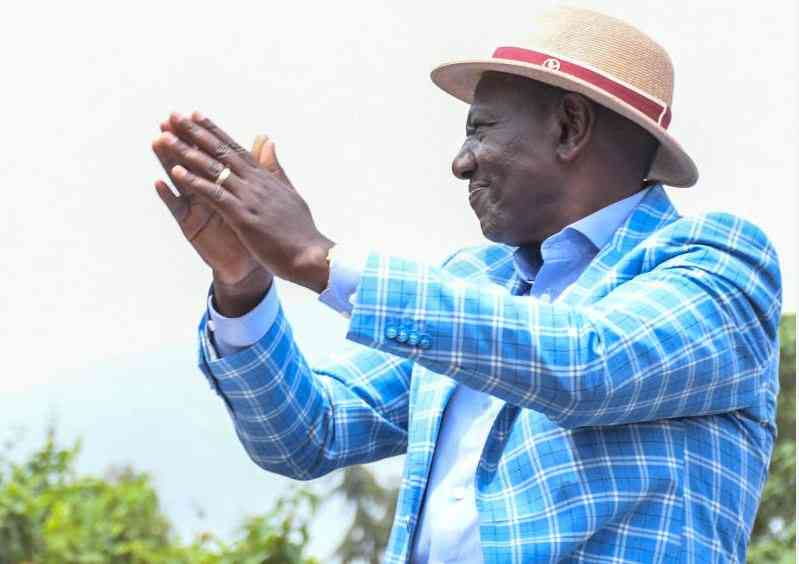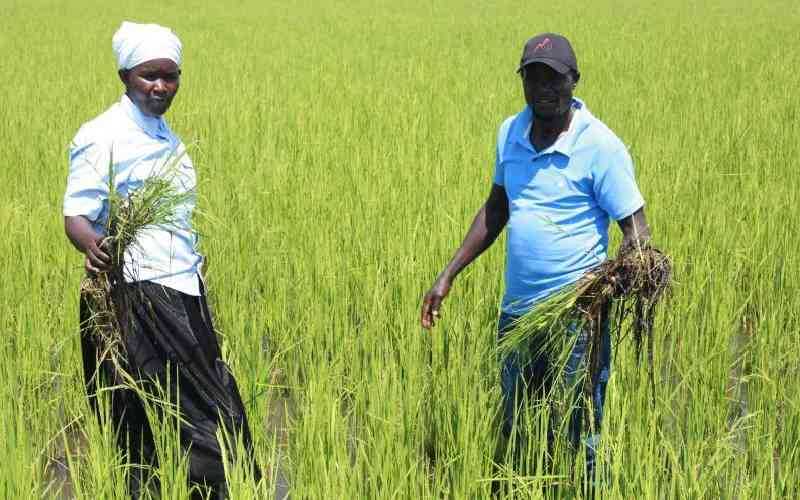
Kisumu County government has pumped Sh300 million to rehabilitate the collapsed Rice Irrigation schemes. [Kepher Otieno, Standard]
The Ministry of Agriculture and the National Irrigation Authority (NIA) have teamed up in a new strategy to boost rice production in Kisumu and Busia counties.
According to Dr Mary Mutembei, the Head of Rice Promotion Programme in the Ministry of Agriculture, Mwea Irrigation Scheme has been producing rice for a long time and is exhausted in terms of space.
Dr Mutembei said the ministry is currently looking for other areas to plant the crop, and customising improved production technologies that have been tried in Mwea.
“The variety grown in the region is not popular with local market but farmers are quickly picking up new varieties. We are currently in Ahero,” said Dr Mutembei.




“We have invited the private sector also to bring in hybrid rice in this region and the rest of the country. We also have new varieties developed by KALRO in collaboration with the international rice research institute,” she added.
She noted that one of the ministry’s main agendas for the region is to improve market strategy.
“We have seen great investments in the milling sector which was a big challenge in this region. We did not have good milling facilities and as a result, we produced very poor quality rice which could not compete with imported varieties,” she said. “With the private sector coming in to invest in milling facilities and also to mechanise rice production practices, we can see a bright future for the right value chain for this region.”
However, John Odawo, a rice farmer at the Ahero Irrigation Scheme said their main problem is the constant invasion by birds.
Mr Odawo said he is forced to man his rice fields from six o’clock in the morning to around 7pm in the evening to chase away the birds.
“This is our routine here daily, at least until we do our harvests in the next two weeks together with my wife. If we do not keep watch for the birds, we will end up with nothing at the end of the harvest,” he said.
Mr Odawo added that the market is also “a nightmare since we are hardly making any profits after the harvest. We have to sell at lower prices which is a big setback to farmers.”
Another farmer, Bernard Odhiambo, who has been farming rice for over 25 years said they produced very little yields when they began farming years ago.
However, with the introduction of new varieties and different technologies, there is a great improvement.
Stay informed. Subscribe to our newsletter
Mr Odhiambo said some farmers get up to 60 bags of rice harvest, while in the past the maximum yield would only be 25 bags per harvest. He said that besides invasion by birds, farmers also had to contend with a complicated production process.
“And now as we prepare for the harvest season in the next two weeks, we are worried about the coming rains.
“These new varieties which are hybrid do not do well in case of heavy rains with winds and hailstones. If it rains heavily we will be forced to do manual harvesting and this means low yields,” said Mr Odhiambo.
He explained that one bird consumes rice equivalent to its own weight. Therefore if a bird weighs 80 grammes, for example, it will consume that amount in the rice field. Unfortunately, the birds often flock in their thousands.
Joel Tanui, the Nyanza Regional Coordinator for NIA said the organisation is in contact with the crop protection unit and the county government to start a program next month of reducing the bird population in the rice-growing belt.
Mr Tanui said the program is to ensure that during the peak harvest season, the number of birds is low.
“We scout for brooding sites of the birds and estimate the population then chemically reduce them in terms of numbers. We have another program with the county government of Kisumu to reduce the bird population but targeting the species that is feeding on the rice,” he said.
Mr Tanui explained that for the past two years, a programme with farmers and research institutions had been implemented to introduce new rice varieties to farmers.
“For example, a farmer who used to get 25 bags per acre is now getting 45 bags per acre, which is double what they initially got and that has been a very big boost in rice production in this region,” he said.
Mr Tanui further noted that the irrigation board is in touch with the Kenya National Trade Corporation (KNTC) to ensure that locally-produced rice gets market.
“The challenge in the region is with insufficient rice mills that do not give the best quality needed by the KNTC. The local farmers do not meet the quality parameters and therefore they do not sufficiently service the market,” he said, noting that farmers were forced to sell their produce to Ugandan millers.
“The challenge is however being addressed by acquiring a new rice mill in the partnership that will be based in Ahero so that all the farmers can benefit and supply to KNTC,” said Mr Tanui.
The officials said only the Mwea Irigation Scheme is currently producing a high quantity of rice, with Kenya still importing 80 per cent of the commodity. In 2020, Kenya spent about Sh25 billion to import rice.